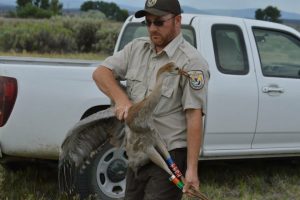Shownotes
Bird Biologist’s Wildlife Research is Aided by Purebred Dogs
Bachman’s GWP CC points a Sandhill Crane colt in order to identify fledgling habitat.
Dominic Bachman, wildlife
biologist, uses his German Wirehaired Pointers to help him conduct research on migratory bird species and habitat management. Bachman spent his childhood with dogs at a wildlife management area in northern Utah, where his father was the manager.
“Any chance I get, I try to bring my dogs into my life,” Bachman said.
Bachman spent his days with his father in the WMA. He watched his father incorporate their dogs into the work.
“Dad would send a dog after a hunter’s lost wounded game,” Bachman said. “The dogs would search hunters who dad suspected had more than their limit. Our dogs would even collect birds killed by disease.”
GWP’s diverse and versatile working ability appealed to Bachman’s father, so he grew up with the breed. He has continued living with the breed and incorporating them into his daily life and work ever since.
Purebred dogs are useful in a variety of wildlife management tasks, Bachman said, including:
- Locating wildlife and assessing populations
- Locating dead bodies, antlers or bone
- Locate scat
- Capturing birds for banding

Baby sandhill cranes, called colts, are banded to trace their migration and habits.
Bachman specifically used his GWP while working with sandhill cranes in northeast California. He convinced his boss to let him incorporate the dogs into locating the baby cranes, called colts, in order to band them.
Host of his own podcast,
Western Bird Biologist, Bachman’s description of capturing baby cranes that are 2 1/2 to 3 feet tall while the crane mothers are attempting to distract the dogs to protect their babies is laugh out loud funny.
Bachman’s research, using dogs, was able to provide valuable information supporting the habitat management plans.
German Wirehaired Pointers are particularly well suited to the work due to their development as very versatile field dogs, Bachman said. They work on land and in water, they track wounded game, they adjust their range to the terrain.
“The versatile hunting dog is a perfect dog for a lot of wildlife research,” Bachman said. “It blows my mind what they can do. There is a dog in biology that has been trained to smell a plant pathogen.”